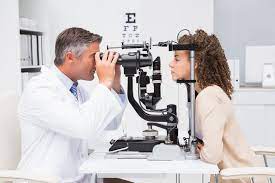10 Common Eye Conditions, When to Worry and When to see a Doctor

Here are 10 common eye conditions, along with information on when to worry and when to see a doctor:
- Dry Eyes: Dryness, grittiness, or blurred vision due to insufficient tears. A pharmacist can help sort in most people.
- When to worry: Persistent dryness, pain, or vision changes.
- When to see a doctor: If symptoms persist or worsen despite using over-the-counter drops.
- Conjunctivitis (‘Red’ or ‘Pink Eye’): Inflammation or infection of the conjunctiva, causing redness, itching, and discharge. It is usually bacterial or viral, and can be dealt with my a pharmacist.
- When to worry: Severe pain, vision changes, or intense redness.
- When to see a doctor: If symptoms worsen or don’t improve with treatment.
- Cataracts: Clouding of the lens, causing blurry vision, glare, or halos.
- When to worry: Significant vision loss or impact on daily activities.
- When to see a doctor: If symptoms interfere with daily life; surgical evaluation may be necessary.
- Glaucoma: Damage to the optic nerve, due to increased pressure within the eye, leading to visual loss.
- When to worry: Gradual peripheral vision loss or tunnel vision.
- When to see a doctor: Regular check-ups are crucial; early detection is key, as treatment is effective
- Age-related Macular Degeneration (AMD): Progressive damage to the macula, causing central visual loss.
- When to worry: Distorted vision, blind spots, or difficulty reading.
- When to see a doctor: If symptoms appear or worsen; early treatment can slow progression.
- Diabetic Retinopathy: Damage to retinal blood vessels due to diabetes, potentially causing visual loss.
- When to worry: Blurred vision, floaters, or sudden visual loss.
- When to see a doctor: Regular eye examination is essential for people with diabetes; timely treatment (e.g. with laser therapy) can prevent visual loss.
- Astigmatism: Irregularly shaped cornea or lens, causing blurred vision at all distances.
- When to worry: Persistent blurry vision, headaches, or eye strain.
- When to see a doctor: If symptoms impact daily activities; glasses, contact lenses lenses or surgery may be options.
- Presbyopia: Also known as age-related long-sightedness, is a condition that causes difficulty in focusing on nearby objects as people age. It’s a natural part of the aging process, typically becoming noticeable around the age of 40.
- When to worry: Difficulty reading or performing daily tasks.
- When to see a doctor: If symptoms impact daily life; glasses or contact lenses can help.
- Floaters and Flashes: Small, dark spots or flashes of light due to age-related changes in the vitreous gel.
- When to worry: Sudden increase in floaters or flashes, especially with visual loss.
- When to see a doctor: If symptoms are severe or sudden; prompt evaluation can rule out retinal detachment.
- Blepharitis: Inflammation of the eyelids, causing redness, itching, and crusting.
- When to worry: Persistent symptoms, pain, or vision changes.
- When to see a doctor: If symptoms don’t improve with self-care or worsen over time.
General Guidelines about Eye Conditions
- Have regular eye examinations to detect conditions early
- Seek immediate attention if you experience:
- Sudden loss of vision (blindness)
- Severe eye pain
- Increased sensitivity to light
- Double vision or distorted vision
- Redness or swelling around the eye.

